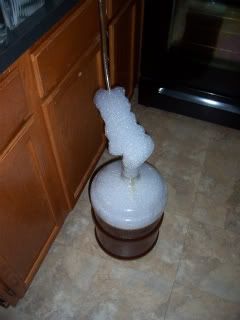Ok here's the back story...
So i think God is trying to tell me something about not brewing yesterday. Saturday night i'm making my yeast starter and I crack my erhlenmeyer flask while i'm sanitizing my starter wort. -$30 & i no longer have viable yeast
Today i realize when i milled my grain at the LHBS, i forgot to grab a pound of Crystal 40, and i'm thinking..."oh well, not a big deal." I get through the mash well and sparge went without a hitch. Got to the boil, finished with no issues, covered the pot and the chiller (not without turning on the hose and having the exit end spurt blazing hot water up into my face - nearly missing my eye) and letting it run while i go to the LHBS, grab the last two packs of 2112 for my beer and head back to the house.
Upon return to the house I get the wort chilled, and pitch and aerate the wort in the kettle prior to racking. I then attach my sanitized hose to the valve and open. After 2-3 gallons pour in a realize that I didn't dump the ~16-20oz of starsan out of the fermenter. Thankfully I had a second fermenter, dumped the starsan first, and then racked the remaining 3 gallons onto the 2nd fermenter. I then place the fermenters in the coldest room in the house. 4 hours later its at 86, 12 hours later its at 68. Unfortunately that's the best i can do when the ground water is 95.
My question posed is this. Other than the massive oversight (i blame heat and dehydration trying to brew while it's 110 outside) of not dumping out the starsan, i have heard that starsan eventually turns into yeast food. I'm pretty sure the yeast are dead in the first fermenter, but at what point does the starsan convert over and could i repitch yeast after the conversion to try and salvage the batch?
Hopefully my next brew day won't be such a cluster....
So i think God is trying to tell me something about not brewing yesterday. Saturday night i'm making my yeast starter and I crack my erhlenmeyer flask while i'm sanitizing my starter wort. -$30 & i no longer have viable yeast
Today i realize when i milled my grain at the LHBS, i forgot to grab a pound of Crystal 40, and i'm thinking..."oh well, not a big deal." I get through the mash well and sparge went without a hitch. Got to the boil, finished with no issues, covered the pot and the chiller (not without turning on the hose and having the exit end spurt blazing hot water up into my face - nearly missing my eye) and letting it run while i go to the LHBS, grab the last two packs of 2112 for my beer and head back to the house.
Upon return to the house I get the wort chilled, and pitch and aerate the wort in the kettle prior to racking. I then attach my sanitized hose to the valve and open. After 2-3 gallons pour in a realize that I didn't dump the ~16-20oz of starsan out of the fermenter. Thankfully I had a second fermenter, dumped the starsan first, and then racked the remaining 3 gallons onto the 2nd fermenter. I then place the fermenters in the coldest room in the house. 4 hours later its at 86, 12 hours later its at 68. Unfortunately that's the best i can do when the ground water is 95.
My question posed is this. Other than the massive oversight (i blame heat and dehydration trying to brew while it's 110 outside) of not dumping out the starsan, i have heard that starsan eventually turns into yeast food. I'm pretty sure the yeast are dead in the first fermenter, but at what point does the starsan convert over and could i repitch yeast after the conversion to try and salvage the batch?
Hopefully my next brew day won't be such a cluster....



